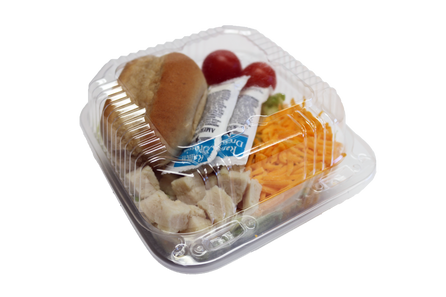The Future of Grab-and-Go Meals in School Cafeterias: Revolutionizing K-12 Food Service
- Kristina Familara
- Apr 23
- 3 min read
In today’s fast-paced educational environments, school cafeteria management faces mounting pressure to deliver nutritious, cost-effective, and time-efficient meal solutions. The rise of grab-and-go meals in K-12 food service is transforming how schools address these challenges, offering innovative ways to enhance student nutrition, streamline cafeteria operations, and boost school meal program participation. This blog explores the future of grab-and-go meal programs, spotlighting trends, benefits, and strategies that resonate with school business officials, district administrators, and food service directors.

Why Grab-and-Go Meals Are the Future of School Food Service
The demand for convenient school meals is surging as student schedules grow busier and school nutrition programs strive to meet diverse dietary needs. Grab-and-go meals—pre-packaged, portable, and ready-to-eat options—are gaining traction for their ability to balance operational efficiency with healthy eating. According to the USDA’s National School Lunch Program, participation rates increase when meals are accessible and appealing, making grab-and-go solutions a game-changer for school food service management.
Key Trends Shaping Grab-and-Go Meal Programs
Technology-Driven Cafeteria Solutions
Schools are adopting point-of-sale (POS) systems, mobile ordering apps, and automated inventory management to streamline grab-and-go meal distribution. These school cafeteria innovations reduce wait times, minimize food waste, and enhance budget management—critical priorities for school business officials.
Sustainable Food Packaging
Eco-friendly packaging is a cornerstone of modern school meal programs. Biodegradable trays, compostable wrappers, and recyclable containers align with sustainability goals, appealing to environmentally conscious district administrators and parents alike.
Customizable Meal Options
To cater to diverse student dietary needs, grab-and-go meals now include plant-based, gluten-free, and allergen-friendly options. This flexibility ensures compliance with USDA nutrition standards while boosting student satisfaction.
Integration with Farm-to-School Programs
Locally sourced ingredients are increasingly featured in grab-and-go menus, supporting farm-to-school initiatives and promoting healthy eating habits. This trend resonates with school districts aiming to strengthen community ties and secure grant funding.
Benefits of Grab-and-Go Meals for School Districts
Enhanced Operational Efficiency
Grab-and-go meals reduce cafeteria congestion, enabling faster service during tight lunch periods. Pre-packaged meals also simplify inventory tracking and food preparation, allowing food service staff to focus on quality control and compliance with federal nutrition guidelines.
Increased Meal Program Participation
Portable meals appeal to students who skip traditional cafeteria lines due to time constraints or social preferences. By offering appealing school meals in accessible formats, schools can boost National School Lunch Program and School Breakfast Program participation, unlocking additional federal reimbursements.
Cost Savings and Budget Optimization
Grab-and-go systems minimize food waste through precise portion control and demand forecasting. For school business officials, this translates to cost-effective food service operations and better allocation of district budgets.
Improved Student Nutrition and Engagement
Nutritious grab-and-go options—like salads, wraps, and fruit cups—encourage healthy eating habits without sacrificing taste. Schools report higher student engagement when meals are visually appealing and easy to access, fostering a positive school dining experience.
Strategies for Implementing Grab-and-Go Meal Programs
For school districts looking to adopt or expand grab-and-go meal programs, strategic planning is essential. Here are actionable steps to ensure success:
Invest in Cafeteria Infrastructure
Upgrade food service equipment—such as refrigerated display cases and mobile carts—to support grab-and-go distribution. Partner with food service vendors to secure cost-effective solutions tailored to your district’s needs.
Leverage Data Analytics
Use cafeteria management software to track meal participation rates, inventory levels, and student preferences. Data-driven insights enable food service directors to optimize menus and reduce operational costs.
Engage Stakeholders
Collaborate with students, parents, and school board members to design grab-and-go menus that reflect community values. Transparent communication builds trust and drives program adoption.
Train Food Service Staff
Provide professional development for cafeteria staff to ensure efficient meal preparation, food safety compliance, and customer service. Well-trained teams are critical to program success.
Challenges and Solutions
While grab-and-go meals offer transformative potential, challenges like initial investment costs, menu fatigue, and equitable access must be addressed. School districts can overcome these hurdles by:
Securing Grants and Funding: Explore USDA grants or state-level funding to offset startup costs for cafeteria upgrades and program implementation.
Rotating Menus: Keep students engaged with diverse, seasonally inspired grab-and-go options to prevent menu fatigue.
Ensuring Accessibility: Deploy grab-and-go stations in multiple locations, such as hallways or libraries, to reach students who avoid traditional cafeteria settings.
The Road Ahead for K-12 Food Service
As school nutrition programs evolve, grab-and-go meals will play a pivotal role in shaping the future of K-12 food service. By embracing innovative cafeteria solutions, sustainable practices, and student-centered menus, schools can deliver nutritious, convenient, and cost-effective meals that meet the needs of today’s learners.
For school business officials, the adoption of grab-and-go meal programs represents an opportunity to enhance district operations, maximize federal funding, and promote student wellness. By staying ahead of food service trends and investing in modern cafeteria systems, schools can create a dining experience that fuels both academic success and operational excellence.
Ready to transform your school cafeteria? Click the button below and learn how we can help launch a program that delivers results for your district and students.
.png)













































Exciting to see how grab-and-go meals are reshaping school cafeterias! Convenience doesn't have to come at the cost of nutrition. Providers like Glandore Foods are leading the way with their reliable school catering service, offering quick, healthy options that keep students energized and focused throughout the day.